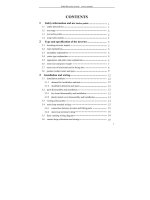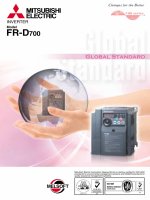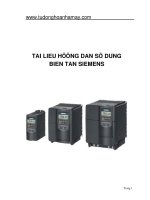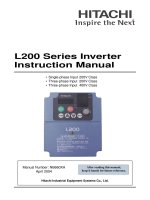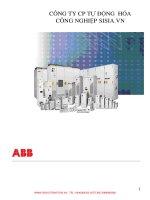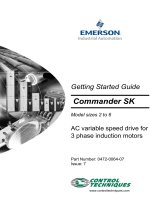tài liệu biến tần ENC EN500 EN600 manual
Bạn đang xem bản rút gọn của tài liệu. Xem và tải ngay bản đầy đủ của tài liệu tại đây (4.68 MB, 278 trang )
Print version: V2.0-A2
Foreword
Thank you for purchasing EN500/EN600 series inverter developed and produced
by Shenzhen Encom Electric Technologies CO., LTD.
EN500/EN600 series hi-performance flux vector inverter adopt advanced control
mode to achieve high torque, high precision and wide-range speed regulation
drive, and it also support speed sensorless torque control and PG control torque.
It can meet customer all kinds of requirement to universal inverter. EN500/EN600
inverter is a organic combination for customer’s universal and industrial control
purpose and provide practical main-auxiliary frequency provision, run channel
frequency binding, PID regulator, simple PLC, spinning traverse, programmable
input&output terminal control, pulse frequency provision and inbuilt Modbus,
Can bus, Profibus, 485 freedom protocol and other function and platform. It
provide high integration solution for most manufacturing and automation
customer and EN500/EN600 inbuilt input phase loss function, output phase loss
function, short circuit to earth grounding function and many other protective
function to improve effectively the system reliability and safety.
This brochure provide the installation and wiring, settings, fault check and
methods, maintenance and other relative issues to customer. To make inverter
assemble and operate rightly, and use its high performance to best, please read this
brochure carefully before installation usage and keep them well to the final users
of inverter.
Please contact our office or dealer anywhere at any moment when you have any
doubts or special demands in using these inverters, and you can also contact our
after service center in our Headquarters directly. We will serve you with all our
heart.
We reserve our right to notice you if we change contents of this manual.
Print version: V2.0-A2
Foreword
Thank you for purchasing EN500/EN600 series inverter developed and produced
by Shenzhen Encom Electric Technologies CO., LTD.
EN500/EN600 series hi-performance flux vector inverter adopt advanced control
mode to achieve high torque, high precision and wide-range speed regulation
drive, and it also support speed sensorless torque control and PG control torque.
It can meet customer all kinds of requirement to universal inverter. EN500/EN600
inverter is a organic combination for customer’s universal and industrial control
purpose and provide practical main-auxiliary frequency provision, run channel
frequency binding, PID regulator, simple PLC, spinning traverse, programmable
input&output terminal control, pulse frequency provision and inbuilt Modbus,
Can bus, Profibus, 485 freedom protocol and other function and platform. It
provide high integration solution for most manufacturing and automation
customer and EN500/EN600 inbuilt input phase loss function, output phase loss
function, short circuit to earth grounding function and many other protective
function to improve effectively the system reliability and safety.
This brochure provide the installation and wiring, settings, fault check and
methods, maintenance and other relative issues to customer. To make inverter
assemble and operate rightly, and use its high performance to best, please read this
brochure carefully before installation usage and keep them well to the final users
of inverter.
Please contact our office or dealer anywhere at any moment when you have any
doubts or special demands in using these inverters, and you can also contact our
after service center in our Headquarters directly. We will serve you with all our
heart.
We reserve our right to notice you if we change contents of this manual.
Content
1
2
Safety information and use notice points
1.1 Safety precautions
1
1.2 Application range
3
1.3 Use notice points
3
1.4 Scraping handling notice
4
Inverter type and specification
5
2.1 Incoming inverter inspect
5
2.2 Type explanation
5
2.3 Nameplate explanation
5
2.4 Inverter type explanation
6
2.5 Appearance and parts name explanation
7
2.6 Outer size
8
2.7 EN500 optional base
10
2.8 Outer size of keypad and its fixing box
12
2.9 Product technic index and spec
3
1
Installation and wiring
3.1 Installation ambient
13
16
16
3.1.1 The demands for installation ambient
16
3.1.2 Installation direction and space
16
3.2 Parts disassembly and installation
17
3.2.1 Keyboard disassembly and installation
17
3.2.2 Cover disassembly and installation
17
3.3 Wiring notice points
18
3.4 Main loop terminal wiring
19
3.4.1 Connection between inverter and fitting parts
21
3.4.2 Main loop terminal wiring
21
3.5 Basic running wiring diagram
25
3.6 Control loop collocation and wiring
25
3.6.1 Relative location and function for control
board terminal and slide switch
25
4
3.6.2 Descriptions for control board terminal
27
3.6.3 Analog input&output terminal wiring
29
3.6.4 Digital input terminal wiring
30
3.6.5 Communication terminal wiring
32
EMC Electromagnetic compatibility explanation
4.1 Noise interference restraining
5
34
4.1.1 Interference noise type
34
4.1.2 Basic countermeasure for restrain interference
35
4.2 Field wiring and earth grounding
36
4.3 Leak current and countermeasure
36
4.4 Installation demand for electromagnetic on-off electronic device
37
4.5 Noise filter installation instructions
37
Run and operation explanation for inverter
38
5.1 Run of inverter
38
5.1.1 Running order channels
38
5.1.2 Frequency-provision channel
38
5.1.3 Work state
39
5.1.4 Run mode
40
5.2 Operation and use of key board
42
5.2.1 Keypad layout
42
5.2.2 Keypad function description
42
5.2.3 LED and indicator light
43
5.2.4 Key board display status
43
5.2.5 User Management Parameters
46
5.2.6 Method for operating keypad
46
5.3 Inverter electrification
6
34
49
5.3.1 Check before electrification
49
5.3.2 First electrification
49
Function parameter schedule graph
50
6.1 Symbol description
50
6.2 Function parameter schedule graph
50
7
Detailed function specification
90
7.1 System Parameter Group: F00
90
7.2 Basic Run Function Parameter Group:F01
99
7.3 Start, stop, forward/reverse,
brake function parameter group: F02
8
108
7.4 V/F control parameter group: F03
114
7.5 Auxiliary running parameter group: F04
117
7.6 Communication control parameter group: F05
123
7.7 Setting curve parameter group: F06
128
7.8 Analog quantity, Pulse input function parameter group: F07
132
7.9 On-off input function parameter group: F08
135
7.10 Switch output function parameter group: F09
150
7.11 Simple PLC/Multi-speed function parameters Group:F10
161
7.12 Closed-Loop PID operation Parameters Group:F11
168
7.13 Constant pressure water supply function parameters Group: F12
175
7.14 Traverse, Fixed-length control Function Parameters Group: F13
178
7.15 Vector Control parameters Group: F14
182
7.16 Motor parameters Group: F15
187
7.17 Closed-loop encoder parameters Group: F16
190
7.18 Reserved parameters Group1:F17
191
7.19 Enhanced Control Functions Parameters Group: F18
192
7.20 Protective Relevant Function Parameters Group:F19
195
7.21 Internal Virtual Input Output Node Parameter Group: F20
206
7.22 Reserved parameter group 2:F21
209
7.23 Reserved parameter group 3:F22
209
7.24 Reserved parameter group 4:F23
209
7.25 Reserved parameter group 5:F24
209
7.26 User Definition Display Parameter Group: F25
210
7.27 Fault Record Function Parameter Group: F26
212
7.28 Password and Manufacturer Function Parameter Group: F27
214
Troubleshooting
215
9
8.1 Failure and countermeasure
215
8.2 Failure record lookup
220
8.3 Failure reset
220
8.4 Alarm reset
221
Maintenance
9.1 Routine maintenance
222
222
9.2 Inspection and replacement of damageable parts
222
9.3 Repair guarantee
223
9.4 Storage
224
Appendix A Modbus communication protocol
225
Appendix B Free-port communication protocol
239
Appendix C
251
Keyboard
C.1 Keyboard selection
251
C.2 LED double display keyboard
251
C.3 LCD keyboard
252
C.4 LED single-display digital potentiometer keyboard
257
C.5 Communication Component
258
Appendix D
Communication extension card
259
D.1 Communication card selection
259
D.2 PROFIBUS-DP communication card
259
D.3 CANopen communication card
262
D.4 CANlink communication card
264
Appendix E
Universal encoder expansion card
266
Appendix F
Braking unit and braking resistance
268
1 Safety information and use notice points
1
Safety information and use notice points
To make ensure personal & equipment safety, this chapter must be read carefully
before the inverter come into use.
1.1 Safety precautions
There are three kinds of safety warnings in this manual as below:
Symbol
Symbol description
!
It may cause human death, serious injury or heavy property loss
with wrong operation.
!
It may result body or device damage with wrong and timeless
precautions under operation.
Note
Should pay extra cautions when inverter in use under this
symbol
1
1 Safety information and use notice points
!
!
!
2
Forbid to cut off the power source directly when inverter under
running, acceleration or deceleration status. Power source could
cut off when inverter completely in halt and standby status.
Otherwise user should be responsible for inverter and device
damage and human injury.
(1) Forbid to connect AC power source to output terminal U,V,W,
otherwise it could cause inverter completely damage.
(2) Not allow for short circuit between(-)and(+) otherwise it could
cause inverter damage and power source short circuit.
(3) Forbid to install inverter on flammable objects, otherwise it
may cause fire.
(4) Do not install inverter in a environment with explosive gas, it
may cause explosion.
(5) Bare connection terminal should be insulation treatment after
main loop connection, otherwise it may cause electric shock.
(6) Do not operate inverter with wet hands when inverter power
on, otherwise it may cause electric shock.
(7) Inverter earth terminal should be well grounding connection.
(8) Do not open the front cover for wiring when inverter power on.
Inverter wiring and check must handle after 10 minutes of
inverter power off.
(9) Wiring connection should handle by qualified person and not
allow to slip any conductive objects inside inverter, otherwise it
may cause a electric shock or inverter damage.
(10) when inverter stocked for more than 6 months, using voltage
regulator to boost voltage up and keep inverter in standy status
for 1 hour, otherwise it may cause electric shock and explosion.
(1) Forbid to connect control terminals except TA, TB, TC to AC
220V/380V signal, otherwise it may cause inverter completely
damage.
(2) Do not install and run inverter when inverter damage or spare
part less, otherwise it may cause fire or human injury.
(3) inverter should install in a place where can accept itself weight,
otherwise it may cause inverter drop down or belongings damage.
1 Safety information and use notice points
1.2
Application range
(1) This kind of inverter apply to 3 phase ac asynchronous motor only for general
industry.
(2) It should handle cautiously and consult with manufacturer when inverter apply
to high reliability required equipment which relevant to life, properties and safety
device.
(3) This kind of inverter is the general motor control device in industry. When
inverter apply to dangerous equipment, safeguard should be considerable in case
of inverter failure.
1.3 Use notice points
(1) EN500/EN600 series inverter belong to voltage type inverter, and it is normal
with up temperature, noise and vibration of motor increasing over power
frequency run slightly.
(2) It is required to match inverter with variable frequency motor running at low
speed with constant torque for long time. When match inverter with general
asynchronous motor running at low speed, it should take measures to make motor
heat dissipation or monitoring motor temperature in avoid of motor flash.
(3) It is necessary to take measures in advance for the damage caused for the bad
lubrication of the reduction box and wheel gear mechanical devices running at
low speed for long time.
(4) It is necessary to assure at first that the use speed range of motor bearings and
mechanical devices, also the increasing of motor vibration and noise should be
considered, when motor run over rated frequency.
(5) It is necessary to select the suitable brake assembly for hoisting device and big
inertia load to make sure the normal work when inverter stripping from power
grid for the overcurrent or overvoltage failure.
(6) Inverter start and stop control through terminal or other normal command
channel, otherwise it may cause inverter damage via connecting inverter input
terminal to big current switch just like contactor direct to start and stop inverter
frequently.
(7) It is necessary to make sure inverter cut off from operation without output,
when inverter and motor connect through switch components just like contactor
etc. Otherwise it will cause inverter damage.
(8) When inverter output frequency within some range, it may meet mechanical
resonance point of load device, through setting jump frequency to avoid it.
(9) Checking power supply voltage within allowed working range before usage,
otherwise, it need to change voltage or custom special voltage inverter.
3
1 Safety information and use notice points
(10)When inverter usage site altitude over1000 meters inverter should derate
current to use, output current decrease about 10% of rated current per 1000 meters
increase.
(11)Motor should do insulation check before first usage or reusage after lay aside
for long time. Checking method show as graph 1-1 below with 500V voltage type
megohm meter , insulation resistance should not smaller than 5 M
otherwise
inverter maybe damaged.
(12)Forbid inverter output side to assemble capacitor to improve power factor or
anti-thunder dependent resistor etc, otherwise it may cause inverter fault trip or
component damage show as graph 1-2.
EN500/EN600
After wiring finish, short-circuit U,V,W
to measure insulation resistance
U VW
②
EN500/EN600 V
EDS1000
motor
M
W
Ground
Megohmmeter
Fig.1-1 motor insulation check
Fig.1-2 capacitor at output side forbidden
1.4 Scraping handling notice:
Notices when handling with scrapped inverter and components:
(1) The unit: dispose the inverter as industrial waste.
(2) Electrolytic capacitor: It may cause explosion when electrolytic capacitor
under burning.
(3)Plastic: it may result in harmful and poisonous gas when plastic and rubber of
inverter burning, and safeguard preparations should be taken before burning.
4
2 Inverter type and specification
2
Inverter type and specification
2.1 Incoming inverter inspect
(1) Check if there is damage during transportation and inverter itself has damage
or fall-off parts.
(2) Check if parts presented in packing list are all ready.
(3) Please confirm nameplate data of the inverter is in line with your order
requirement.
Our product is guaranteed by strict quality system during manufacturing, packing,
transportation etc., please contact our company or local agent rapidly
if some careless omission or mistake arise, we’ll deal with it as soon as
possible.
2.2 Type explanation
Code
Name
EN500
Series No.
EN600
Series No.
Code
Volt. grade
2S
1 phase 220V
Code
accessories
B
Inbuilt brake unit
Code
Dedicated fan
&pump
motor power
(KW)
3 phase 380V
0015P
1.5
0022P
2.2
Code
Constant torque
general type
motor power
(KW)
6300P
630
0004
0.4
0007
0.75
5600G
560
6300G
630
4T
Fig.2-1 Type description
2.3 Nameplate explanation
Nameplate presented as figure 2-2 with type and rating data at the bottom of
inverter right side.
Series No.
Type
Rated input vol. And freq.
Motor power and output current
Serial No.
Manufacturer and origin
Fig.2-2 Nameplate
5
2 Inverter type and specification
2.4 Inverter type explanation
Input
Voltage
1 phase
220V
3 phase
380V
6
Inverter type
Rated output
Current(A)
Adaptable motor
(KW)
EN600-2S0004
2.5
0.4
EN600-2S0007
4
0.75
EN600-2S0015
7
1.5
EN600-2S0022
10
2.2
EN600-2S0037
15
3.7
EN600-4T0007G/0015P
2.3/3.7
0.75/1.5
EN600-4T0015G/0022P
3.7/5
1.5/2.2
EN600-4T0022G/0037P
5/8.5
2.2/3.7
EN600-4T0037G
8.5
3.7
EN600-4T0055P
13
5.5
EN600-4T0055G/0075P
13/17
5.5/7.5
EN600-4T0075G/0110P
17/25
7.5/11
EN600-4T0110G/0150P
25/33
11/15
EN600-4T0150G/0185P
33/39
15/18.5
EN600-4T0185G/0220P
39/45
18.5/22
EN600-4T0220G/0300P
45/60
22/30
EN600-4T0300G/0370P
60/75
30/37
EN600-4T0370G/0450P
75/91
37/45
EN600-4T0450G/0550P
91/112
45/55
EN600-4T0550G/0750P
112/150
55/75
EN500-4T0750G/0900P
150/176
75/90
EN500-4T0900G/1100P
176/210
90/110
EN500-4T1100G/1320P
210/253
110/132
EN500-4T1320G/1600P
253/304
132/160
EN500-4T1600G/2000P
304/380
160/200
EN500-4T2000G/2200P
380/426
200/220
EN500-4T2200G/2500P
426/474
220/250
EN500-4T2500G/2800P
474/520
250/280
EN500-4T2800G/3150P
520/600
280/315
EN500-4T3150G/3550P
600/650
315/355
EN500-4T3550G/3750P
650/680
355/375
EN500-4T3750G/4000P
680/750
375/400
EN500-4T4000G/4500P
750/800
400/450
2 Inverter type and specification
EN500-4T4500G/5000P
800/870
EN500-4T5000G/5600P
870/940
500/560
EN500-4T5600G/6300P
940/1100
560/630
EN500-4T6300G
1100
630
450/500
2.5 Appearance and parts name explanation
2.5.1 EN600 Appearance and parts name explanation
Upcover
plate
LED digital tube
LED digital tube
Operation keyboard
Upcover
plate
Operation keyboard
Down cover plate
Down cover plate
Control cable inlet
Nameplate
Control cable
inlet
Input & output
power cable
inlet
Fan hole
Nameplate
Fan hole
Input & output
power cable inlet
Fig.2-3 EN600 Parts name sketch
2.5.2 EN500 Appearance and parts name explanation
Operation keyboard
Cover door
Operation keyboard
Upcover
plate
Input & output
power cable inlet
Control cable inlet
Bottom installation
hole
Input & output
power cable
inlet
Control cable inlet
Bottom installation hole
Fig.2-4 EN500 Parts name sketch
7
2 Inverter type and specification
H
B
B
H
2.6 Outer size
A
W
A
D
W
D
D1
Fig.a
D
A detail
W
W1
N1
B detail
W2
N1
M1
N2
A detail
Fig.c
B detail
N2
M1
1
M
B detail
A detail
M2
8
D
Adetail
H1
H
H1
H
W
W1
Fig.b
M
Fig.d
M1
2
B detail
2 Inverter type and specification
D
H
W
M2
D1
W1
M1
Fig.e
Fig.2-5 outer dimension
Table 2-1
Inverter type
EN600 mounting size
A
(mm)
B
(mm)
W
(mm)
H
(mm)
D
(mm)
D1
(mm)
Fix Hole
Fig. No.
(mm)
104
186
115
200
151
-
5
Fig.a
129
227
140
240
175
-
5
Fig.a
104
186
115
200
151
-
5
Fig.a
129
227
140
240
175
-
5
Fig.a
165
281
180
304
189
-
6
Fig.a
180
382
250
398
210
214
9
Fig.b
180
434
280
450
240
244
9
Fig.b
EN600-2S0004
EN600-2S0007
EN600-2S0015
EN600-2S0022
EN600-2S0037
EN600-4T0007G/0015P
EN600-4T0015G/0022P
EN600-4T0022G/0037P
EN600-4T0037G
EN600-4T0055P
EN600-4T0055G/0075P
EN600-4T0075G/0110P
EN600-4T0110G/0150P
EN600-4T0150G/0185P
EN600-4T0185G/0220P
EN600-4T0220G/0300P
EN600-4T0300G/0370P
EN600-4T0370G/0450P
9
2 Inverter type and specification
EN600-4T0450G/0550P
190
504.5
290
530
250
254
Fig.b
9
EN600-4T0550G/0750P
Table 2-2
EN500 mounting size
H
(mm)
H1
(mm)
W
(mm)
W1
(mm)
W2
(mm)
D
(mm)
D1
(mm)
N1
(mm)
N2
(mm)
570
546
340
237
-
320
-
-
650
628
400
297
-
340
-
980
953
480
370
-
400
1030
1003
500
370
-
EN500-4T2800G/3150P 1368
1322
700
500
440
Inverter type
EN500-4T0750G/0900P
M1
(mm)
M2
(mm)
-
12
18
-
-
12
18
-
38
19
9
18
400
-
38
19
9
18
430
-
52
19
12
22
Fig.
No.
EN500-4T0900G/1100P
EN500-4T1100G/1320P
EN500-4T1320G/1600P
EN500-4T1600G/2000P
EN500-4T2000G/2200P
Fig.c
EN500-4T2200G/2500P
EN500-4T2500G/2800P
EN500-4T3150G/3550P
Fig.d
EN500-4T3550G/3750P
1483
700
500
500
430
-
OB
77*47
1650
-
850
700
-
550
490
-
-
40
13
1700
-
900
750
-
550
490
-
-
40
13
EN500-4T3750G/4000P 1518
19
12
22
EN500-4T4000G/4500P
EN500-4T4500G/5000P
EN500-4T5000G/5600P
EN500-4T5600G/6300P
Fig.e
EN500-4T6300G
2.7 EN500 optional base
2.7.1 EN500 inverter and base selection table
Type
Standard base
EN500-4T0750G/0900P
Base model
base with Input
Base with
reactor
output reactor
base with DC
reactor
SP-BS-0750-LI
SP-BS-0900-LO
SP-BS-0750-LD
EN500-4T0900G/1100P
SP-BS-0900-LI
SP-BS-0900-LO
-
EN500-4T1100G/1320P
SP-BS-1100-LI
SP-BS-1100-LO
-
SP-BS-1320-LI
SP-BS-1320-LO
-
SP-BS-0900
SP-BS-1320
EN500-4T1320G/1600P
EN500-4T1600G/2000P
SP-BS-1600
EN500-4T2000G/2200P
SP-BS-1600-LI
SP-BS-1600-LO
-
SP-BS-2000-LI
SP-BS-2000-LO
-
SP-BS-2200
EN500-4T2200G/2500P
SP-BS-2200-LI
SP-BS-2200-LO
-
SP-BS-2500-LI
SP-BS-2500-LO
-
EN500-4T2800G/3150P
SP-BS-2800-LI
SP-BS-2800-LO
-
EN500-4T3150G/3550P
SP-BS-3150-LI
SP-BS-3150-LO
-
EN500-4T3550G/3750P
SP-BS-4000-LI
SP-BS-4000-LO
-
EN500-4T2500G/2800P
10
SP-BS-4000
2 Inverter type and specification
EN500-4T3750G/4000P
SP-BS-4000-LI
SP-BS-4000-LO
-
EN500-4T4000G/4500P
SP-BS-4000-LI
SP-BS-4000-LO
-
W
Ho
Ho
2.7.2 Base outer dimension
D1
D1
W
Fig.a
Fig.b
Fig.2-6 base dimension
Table 2-3 base size
Base model
W
mm
D1
mm
Ho
mm
Fig.
SP-BS-0900
340
300
180
Fig.a
340
300
350
400
320
180
400
320
380
SP-BS-1600
480
380
180
SP-BS-1600-LI
480
380
400
SP-BS-0750-LI
SP-BS-0750-LD
SP-BS-0900-LI
SP-BS-0900-LO
SP-BS-1320
SP-BS-1100-LI
SP-BS-1100-LO
SP-BS-1320-LI
SP-BS-1320-LO
11
2 Inverter type and specification
SP-BS-1600-LO
SP-BS-2200
500
380
200
500
380
400
700
430
204
700
430
400
700
430
450
SP-BS-2000-LI
SP-BS-2000-LO
SP-BS-2200-LI
SP-BS-2200-LO
SP-BS-4000
SP-BS-2500-LI
SP-BS-2500-LO
SP-BS-2800-LI
SP-BS-2800-LO
Fig.b
SP-BS-3150-LI
SP-BS-3150-LO
SP-BS-4000-LI
SP-BS-4000-LO
2.8 Outer size of keypad and its fixing box(unit:mm)
88
107.5
109.5
Fig.2-7 Mounting size of keypad
Note
12
134.5
64.5
16
140
67
82.8
17.9
Fig.2-8 Hole size of keypad
1. EN-LCD2 long-distance keypad outer lead, do not support
keypad holder installed, only keypad installed support, mounting
size refer to Fig.2-7.
2. Except EN-LCD2 long-distance keypad, when other keypad
outer lead, user can adjust the hole size under actual situation on
keypad or keypad holder; thickness of install board between 1.0
1.5mm is suggested.
3. When installed with keypad holder, it need to buy extra.
2 Inverter type and specification
2.9 Product technic index and spec
Item
Item description
Input
Output
Control Performance
1 phase 220V Grade 1 phase 220V, 50Hz/60Hz
Rating volt., frequency
3 phase 380V Grade 3 phase 380V, 50Hz/60Hz
1 phase 220V Grade 200 260V
Allowed volt. range
3 phase 380V Grade 320 460V
Voltage
0 380V
Frequency
0 600Hz
G type 150% of rated current for 1 minute;
Over loading capacity
P type 120% of rated current for 1 minute.
vector control, PG vector control, open-loop V/F control, torque
Control mode
control, PG torque control
±0.5% rated synchronous speed vector control
Velocity control
±0.1% rated synchronous speed PG vector control
precision
±1% rated synchronous speed V/F control
1 2000 PG vector control
Speed regulation range 1 100 vector control
1 50 V/F control
1.0Hz 150% rated torque V/F control
Start-up torque
0.5Hz 150% rated torque (vector control)
0Hz 180% rated torque PG vector control
±0.3% rated synchronous speed vector control
Speed fluctuation
±0.1% rated synchronous speed PG vector control
Torque control
±10% rated torque vector control torque control
precision
±5% rated torque PG vector control PG torque control .
Torque response
Frequency precision
Freq.
resolution
Analog
setting
Digital
setting
precision
Exterior
impulse
Torque boost
≤20ms
≤10ms
vector control
PG vector control
Digital setting max. frequency×±0.01% Analog setting max.
frequency×±0.5%
0.1% of max. frequency
0.01Hz
0.1% of max. frequency
Automatic torque boost manual torque boost 0.1
12.0%
V/F curve(volt.
Frequency
characteristic)
Setting rated frequency at the range of 5 650Hz by choosing
constant torque, degressive torque 1, degressive torque 2,
degressive torque 3, self-defined V/F total 5 kinds of curve.
Acceleration
Deceleration curve
Two modes straight line acceleration and deceleration; S curve
acceleration and deceleration; 15 kinds of acceleration and
deceleration time time unit (0.01s, 0.1s, 1s) for option max. time
for 1000 minutes.
13
2 Inverter type and specification
brake
EN600 3 phase 15KW & under power range with inbuilt brake
unit only add brake resistor between + and PB.
Power
18.5KW & up power range is possible to add brake unit between
consumption
+ and - outside; or extra connect brake unit with adding brake
brake
resistor between + and PB.
EN500 series can connect brake unit between + and - outside.
Start, stop action for option, action frequency 0 15Hz action
DC brake
current 0 100% of rated current action time 0 30.0s
jog
Multi-section speed
run
Jog frequency range 0Hz up limit frequency jog acceleration
and deceleration time 0.1 6000.0 seconds for setting.
Realized by inbuilt PLC or control terminal; with 15 section speed,
each section speed with separately acceleration and deceleration
time; with inbuilt PLC can achieve reserve when power down.
Inbuilt PID controller Convenient to make closed-loop control system
Automatic energy
saving run
Automatic voltage
regulate(AVR)
Automatic current
limiting
carrier modulation
Optimize V/F curve automatically to achieve power saving run
according to the load status.
Automatically keep output voltage constant, when the power grid
voltage fluctuation
Current limited automatically under run mode in avoid of inverter
over-current frequently to trip.
Modulate carrier wave automatically according to the load
characteristic.
Speed tracking restart Make rotating motor smoothly start without shocking
Running function
running command
specified channel
Keypad specified, control terminal specified, communication
specified can switch through various means.
Running frequency
specified channel
Main & auxiliary specified to a realize one main adjusting and one
fine control. Digital specified, analog specified, pulse specified,
pulse width specified, communication specified and others, which
can be switched by many means at any time.
Binding function
Run command channel and frequency specified channel can bind
together randomly and switch synchronously
Channel 8 for universal digital input, max. Frequency 1KHz,
Digital input channel channel 1 can be used as pulse input channel, max. Input 50KHz
which can be expanded to channel 14 .
Input output characteristic
14
Analog input channel
Channel 2 for analog input channel, AI1 can choose 4 20mA or
0 10V output AI2 is differential input channel 4 20mA or
-10 10V for option which can be expanded to channel 4 analog
input.
Pulse output channel
0.1
20KHz pulse square signal output to achieve setting
frequency, output frequency and other physical quantity output.
Analog output channel
Channel 2 for analog signal output, AO1 can choose 4 20mA or
0 10V AO2 can choose 4 20mA or 0 10Vto achieve setting
frequency, output frequency and other physical quantity output,
which can be expanded to channel 4 analog output.
2 Inverter type and specification
Rapid current limit
Unique function
Monopulse control
Fixed length control Realize fixed length control
Timing control
Virtual terminal
keypad
Keypad display
Button Locked
Protection function
Application site
Altitude
Environment
Environment
temperature
Lock all or part of the buttons
Motor power on Shot circuit test, input & output phase loss
protection, over-current protection, over voltage protection, under
voltage protection, over heat protection, overload protection, under
load protection, relay absorption protection, terminal protection
and no stop protection under power off.
Indoor, not bare to sunlight, no dust, no corrosive gas, no
flammable gas, no vapor, no water drop or salt etc.
Under 1000 meter. above 1000 meter require to reduce volume to
use, output current reduce about 10% of rated currenvolt per 1000
meter high
-10
+40 ( environment temperature between 40
50 ,
need to reduce volume or strengthen heat sink )
Smaller than 5.9 M/S²(0.6g)
structure
Storage temperature
-40
Protection grade
IP20
Cooling mode
Installation mode
Note
Timing control function: setting time range 0.1Min
6500.0Min
Five group virtual input & output IO can realize simply logical
control
The parameters as setting frequency, output frequency, output
voltage, output current can be displayed
Environment humidity Smaller than 95%RH no drop condenses
Vibration
!
Limit inverter over current to the greatest point, and make it run
more stably
Suitable for working site where need one button to control inverter
start and stop, first press to start, then press to stop, and that cycle
repeats. Its very simple and reliable.
+70
Forced air cooling and natural
Wall hanging and cabinet installation
To get a perfect usage performance of the inverter, Please check and
select right type according to this chapter before wiring.
It is necessary to select right type, otherwise it may cause motor
abnormal run or inverter damage.
15
3 Installation and wiring
3
Installation and wiring
3.1 Installation ambient
3.1.1
The demands for installation ambient
(1) Installed in drafty indoor place the ambient temperature should be within
-10ºC~40ºC it needs external compulsory heat sink or reduce the volume if
temperature is over than 40ºC; when temperature under -10 , please preheat
inverter first.
(2) Avoid installing in places with direct sunlight, much dust, floating fiber and
metal powder.
(3) Don’t install in place with corrosive, explosive gas.
(4) The humidity should be smaller than 95%RH without condensation water.
(5) Installed in place of plane fixing vibration smaller than 5.9m/s²(0.6g).
(6) Keep away from electromagnetic disturbance source and other electronic
apparatus sensible to electromagnetic disturbance.
3.1.2 Installation direction and space
(1) Normally the inverter should be mounted vertically, horizontal mounting will
seriously affect heat dissipation and the inverter must be used in lower volume.
(2) Demand for minimum mounting space and distance please see Fig.3-1.
(3) When installing multiple inverters up and down, leading divider must be
applied between them, see fig. 3-2.
Fan exhaust
Fan exhaust
200mm above
110mm above
100mm
50mm
above
above
above
a
110mm
above
above
above
above
15KW & down power
Fig.3-1 mounting space
16
100mm
50mm
200mm above
b
18.5KW & up power
3 Installation and wiring
Leading divider
Fig.3-2 mounting of multiple inverters
3.2 Parts disassembly and installation
3.2.1 Keyboard disassembly and installation
(1) Disassembly
Let the forefinger press finger inlet on the keypad
Assemble
Assemble
depress fixing flexible plate on the top lightly,
hook
hook
draw it outward, then you can disassemble
the keypad.
(2) Assembly
Assemble
hook mouth
First interface the fixed hook of on the bottom
hook
of keyboard with the keyboard installation claw
of inverter, then press the fixed shrapnel on the top
of keyboard to push it assemble well properly
(keyboard assemble well when sounding of crisp)
show as Fig.3-3.
Fig.3-3 Keypad assembly
3.2.2 Cover disassembly and installation
3.2.2.1 Cover disassembly and installation
(1) Disassembly
Located the thumbs to the side bayonet,
the ring fingers on the joint of the up and
down cover, with thumbs press inside and
pull upside at the same time until the bayonet
open between cover and whole case, then pull
back cover to make it off the inverter.
snap
joint
Fig.3-4 metal cover disassemble and assembly
17
3 Installation and wiring
(2) Assembly
1) tilt cover at 5~10 degree
2) interface installation claw with hook on the top of inverter, press down heavily till
cover bayonet enter into the holes of two side completely, show as Fig.3-4.
3.2.2.2 Metal cover disassembly and installation:
(1) Disassembly
First take off 2 screws at the side of the cover
and move it a bit outward horizontally, then tilt
it at 15 degree and draw it outward at the direction
shown in right figure, now you can take the cover off.
(2) Assembly
First put down the cover in parallel with unit body
and make it just locked at two sides of the inverter,
secondly force it ahead and make fixing part on its
top inserted into fixing slot of unit body, at last screw
the cover and finish assembly for the cover.
Fig.3-5 metal cover disassemble
As shown in Fig.3-5
and assembly
3.3 Wiring notice points
!
18
Assure power be cut off completely for above 10 minutes before
wiring, otherwise there is danger of getting electric shock.
Forbid connecting power wire to output U, V, W of the inverter.
If there is current leakage inside inverter, inverter and motor must be
earth grounding for safety assurance, please refer to clause 8 in Chapter
3.4.1 for grounding wiring.
Before shipment compression resistance test of the inverter is
Passed, so users should not conduct compression resistance test again.
Do not add absorbing capacitor or other resistance-capacitor
absorbing device between inverter and motor; also do not add
electromagnetic contact. If contactor and other switch component
needed to add, please make sure inverter suspended without output,
show as Fig.3-6
To provide inverter over-current protection in output side and
convenient maintenance under power off, it should be connected to
power source through air switch and contactor.
Control signal wire should select multicore stranded wire or
shielding wire. One end of the shielding layer hang in the air, and the
other end connect to inverter earth grounding terminal, connection wire
shorter than 20m.

